|
Nigella seeds |
Also known as black onion seeds. These tiny,
angular, deep black seeds have a nutty, peppery flavor. Used in India and
the Middle East as a seasoning for vegetables. Sometimes, it is
erroneously referred to as the black cumin which is an entirely different
species. |
|
|
Noodles, dried rice stick |
Short translucent flat noodles. They need to be soaked in hot water until
soft, then cooked briefly in boiling water until just tender. |
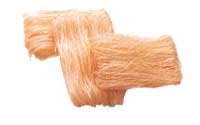 |
|
Noodles, dried soba |
A
specialty of northern Japan. These are beige-colored noodles, made from a
mixture of buckwheat and wheat flours. Some are even lightly flavored with
green tea or beetroot. They are cooked in simmering water, then rinsed in
cold water to cool before use. The boodles are served either hot in a
broth or cold with a dipping sauce. |
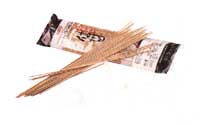 |
|
Noodles, fresh egg |
Made
from egg and wheat flour and are pale yellow. Before use, they need to be
shaken apart and cooked in boiling water until tender and then drained
well. Fresh egg noodles are sold in a range of widths. The noodles are
dusted lightly with flour before packing to stop them from sticking
together. Store in the refrigerator. |
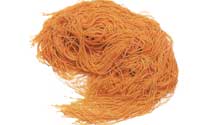 |
|
Noodles, fresh rice |
Made
from a thin dough of rice flour. This is steamed, giving it a firm,
jellylike texture, then lightly oiled and packaged ready for use. The
pearly white noodles need only to be rinsed in hot water to loosen and
separate and then drained. They come in thick or thin varieties, or in a
sheet that can be cut. used in stir-fries or added to simmering dishes
near the end of cooking. Store in the refirgerator. |
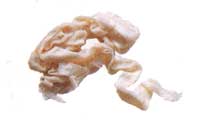 |
|
Noodles, Harusame |
Very
fine, white, almost transparent Japanese noodles. They are made from mung
bean flour and are very similar to dried mung bean vermicelli. Use in the
same way. |
|
|
Noodles, Hokkien |
Also
known as Fukkien or Singapore noodles. They are thick, yellow,
rubbery-textured noodles from wheat flour. They are packaged cooked and
lightly oiled and need no preparation before use. Simply stir-fry or add
to soups or salads. Store in the refrigerator. |
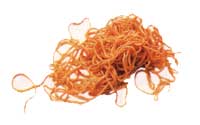 |
|
Noodles, potato starch |
Also
known as Korean vermicelli. They are long, fine. green-brown. translucent
dried noodles. Cook in rapidly boiling water for about 5 minutes or until
plump and gelatinous. Overcooking will make them soggy. |
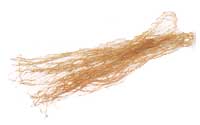 |
|
Noodles, Shanghai |
White noodles made from wheat flour and water, similar to the somen
boodles of Japan. They can be thick or thin. Cook in boiling water before
use. Fresh noodles are dusted lightly with flour before packing to stop
them from sticking together. Store in the refrigerator. Dried wheat flour
noodles are also available. |
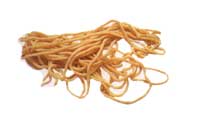 |
|
Noodles, Shirataki |
A
basic ingredient in the Japanese dish sukiyaki. Thin, translucent and
jelly-like, they are made from the starchy root of a plant known in Japan
as devil's tongue. They have a crunchy texture, but little flavor and are
available fresh or dried. Store the fresh noodles in the refrigerator. |
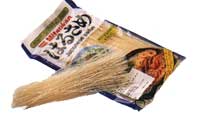 |
|
Noodles, Somen |
Fine, white, dried wheat flour noodles used in Japanese cooking. Before
use, cook in boiling water for 1 to 2 minutes, then rinse in cold water. |
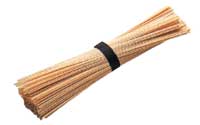 |
|
Noodles, Udon |
White wheat flour noodles used in Japanese cooking. They may be round or
flat. Cook in boiling water or miso soup before used in Japanese soups and
simmered dishes, or can be braised and served with a sauce. |
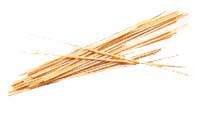 |
|
Nori |
This
is the most common form of dried seaweed used in Japanese and Korean
cooking. It comes in paper thin sheets, plain or roasted. Before use, it
can be toasted lightly over a naked flame to freshen and produce a nutty
flavor. keep in an airtight container or in the freezer. |
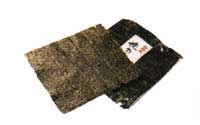 |
|
Nutmeg |
Nutmeg is the seed of Myristica fragrans, an
evergreen tree native to the Molucca Islands. Interestingly, the tree
produces both Nutmeg and mace, and grows up to 60 feet tall. Although the
tree takes seven years to bear fruit, it may produce until the 90th year.
Both spices come from the tree’s fruit, which splits into a scarlet outer
membrane, mace, and an inner brown seed, Nutmeg. |
|

